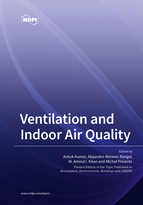Topic Menu
► Topic MenuTopic Editors




Ventilation and Indoor Air Quality

A printed edition is available here.
Topic Information
Dear Colleagues,
Indoor air quality (IAQ) issues have grown in importance since the 1980s for protecting the health and well-being of the public. Many universities introduced indoor air quality courses for the first time during this period. Since then, ventilation standards have been developed over the years by professional associations for engineering design. The application of ventilation to solve IAQ problems has grown exponentially during the current COVID-19 crisis even though ventilation is not enough to eliminate the risk due to air-borne exposure of viruses. Ventilation is playing a critical role as a part of the larger strategy for resolving IAQ issues in modern buildings, schools, restaurants, and others. Poor indoor air quality has been linked to sick building syndrome, reduced productivity of office workers, and impaired learning over the last several decades. Ventilation can help us in controlling indoor humidity as well as contaminant levels. This Topic is aimed at providing the readers with a comprehensive summary of the case studies based on the current work being carried out in applying ventilation principles to solve IAQ problems. This Topic invites the authors to submit papers that exploit the science and technology associated with the ventilation/IAQ. It is strongly recommended that the authors provide a detailed description of the relevant procedures adopted in their respective studies. The papers may range from data collection to modelling to technology development.
This Topic on Ventilation and Indoor Air Quality invites you to submit papers across the broader spectrum of science and engineering (e.g., standards, emission rates, IAQ measurement, ventilation modelling, contaminant control, viruses, IAQ control, risk, life cycle assessment, data analysis, databases, technology, and online learning). The submission of research work by interdisciplinary teams and multi-country groups is of significant interest.
Prof. Dr. Ashok Kumar
Dr. Alejandro Moreno-Rangel
Dr. M. Amirul I. Khan
Prof. Dr. Michał Piasecki
Topic Editors
Keywords
- sick building
- indoor air quality
- contaminant control
- control technology
- viruses
- COVID-19
- ventilation
- IAQ education
- IAQ monitoring
- databases
- life cycle assessment
- IT
- productivity
- learning impact
Participating Journals
| Journal Name | Impact Factor | CiteScore | Launched Year | First Decision (median) | APC |
|---|---|---|---|---|---|

Atmosphere
|
2.9 | 4.1 | 2010 | 17.7 Days | CHF 2400 |

Environments
|
3.7 | 5.9 | 2014 | 23.7 Days | CHF 1800 |

Buildings
|
3.8 | 3.1 | 2011 | 14.6 Days | CHF 2600 |

Pollutants
|
- | - | 2021 | 21.7 Days | CHF 1000 |

International Journal of Environmental Research and Public Health
|
- | 5.4 | 2004 | 29.6 Days | CHF 2500 |

MDPI Topics is cooperating with Preprints.org and has built a direct connection between MDPI journals and Preprints.org. Authors are encouraged to enjoy the benefits by posting a preprint at Preprints.org prior to publication:
- Immediately share your ideas ahead of publication and establish your research priority;
- Protect your idea from being stolen with this time-stamped preprint article;
- Enhance the exposure and impact of your research;
- Receive feedback from your peers in advance;
- Have it indexed in Web of Science (Preprint Citation Index), Google Scholar, Crossref, SHARE, PrePubMed, Scilit and Europe PMC.

